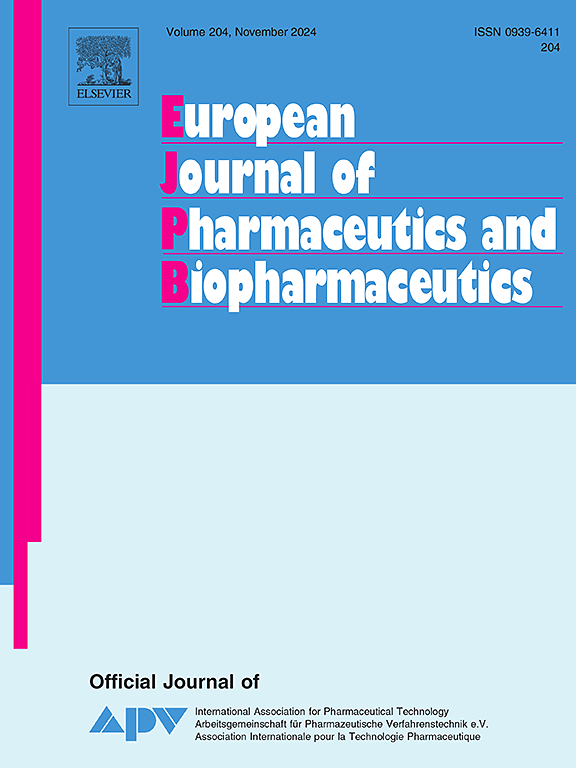Stearic acid-capped mesoporous silica microparticles as novel needle-like-structured drug delivery carriers
IF 4.4
2区 医学
Q1 PHARMACOLOGY & PHARMACY
European Journal of Pharmaceutics and Biopharmaceutics
Pub Date : 2025-02-01
DOI:10.1016/j.ejpb.2024.114619
引用次数: 0
Abstract
Mesoporous silica are widely utilised as drug carriers due to their large pore volume and surface area, which facilitate effective loading. Additionally, they can be used to enhance drugs stability and protect against enzymatic degradation due to their silica framework. However, without the addition of a capping material, the loaded cargo may be prematurely released before reaching the target site. This work reports the functionalisation of a commercially available silica microparticle (SYLOID XDP 3050) with stearic acid at various stearic acid loading concentrations (20–120 % w/w). Scanning electron microscopy (SEM) analysis revealed that the pores were capped with stearic acid, with the filling ratio increasing proportionally to the loading concentration. Notably, needle-like structures appeared when the stearic acid amount exceeded 80 % w/w, surpassing the calculated theoretical maximum pore filling ratio (64.32 %). The molecular interactions were highlighted using Fourier-transform infrared spectroscopy (FTIR), as the intensity of the CH3 increased with increased stearic acid loading concentrations. The needle-structures phenomenon was corroborated by 3D confocal imaging. It utilised the autofluorescence properties of stearic acid to demonstrate its presence within the carrier, with fluorescence intensity increasing alongside the stearic acid concentration. Differential scanning calorimetry (DSC) indicated the crystalline nature of these needle structures, which was further confirmed by X-ray diffraction (XRD) analysis, validating the crystallisation of the stearic acid needles. Moreover, nitrogen porosimetry was employed to assess the pore volume and surface area, where the formulation containing 120 % stearic acid exhibited the lowest pore volume (0.59 cc). This value was smaller than unloaded SYLOID (2.1 cc), indicating near-complete filling of the carrier. This newly developed SYLOID-stearic acid carrier will now be used to enhance formulation development as a platform to enhance protein oral drug delivery.

硬脂酸包覆介孔二氧化硅微颗粒作为新型针状结构药物递送载体。
介孔二氧化硅由于其较大的孔体积和表面积,有利于有效的负载,被广泛用作药物载体。此外,由于其二氧化硅框架,它们可用于提高药物稳定性和防止酶降解。然而,如果没有添加封盖材料,装载的货物可能在到达目标地点之前过早释放。本研究报告了商用二氧化硅微粒(SYLOID XDP 3050)在不同硬脂酸负载浓度(20-120 % w/w)下与硬脂酸的功能化。扫描电镜(SEM)分析表明,孔洞被硬脂酸覆盖,填充率随加载浓度的增加而增加。值得注意的是,当硬脂酸用量超过80 % w/w时,出现针状结构,超过理论计算的最大孔隙填充比(64.32 %)。傅里叶变换红外光谱(FTIR)显示,CH3的强度随着硬脂酸负载浓度的增加而增加。三维共聚焦成像证实了针状结构现象。它利用硬脂酸的自身荧光特性来证明其在载体中的存在,荧光强度随着硬脂酸浓度的增加而增加。差示扫描量热法(DSC)表明了这些针状结构的结晶性质,x射线衍射(XRD)分析进一步证实了硬脂酸针状结构的结晶性。此外,采用氮孔隙率法评估孔隙体积和表面积,其中含有120 %硬脂酸的配方表现出最低的孔隙体积(0.59 cc)。该值小于未加载的SYLOID(2.1 cc),表明载体接近完全填充。这种新开发的syloid -硬脂酸载体现在将用于加强配方开发,作为增强蛋白质口服药物传递的平台。
本文章由计算机程序翻译,如有差异,请以英文原文为准。
求助全文
约1分钟内获得全文
求助全文
来源期刊
CiteScore
8.80
自引率
4.10%
发文量
211
审稿时长
36 days
期刊介绍:
The European Journal of Pharmaceutics and Biopharmaceutics provides a medium for the publication of novel, innovative and hypothesis-driven research from the areas of Pharmaceutics and Biopharmaceutics.
Topics covered include for example:
Design and development of drug delivery systems for pharmaceuticals and biopharmaceuticals (small molecules, proteins, nucleic acids)
Aspects of manufacturing process design
Biomedical aspects of drug product design
Strategies and formulations for controlled drug transport across biological barriers
Physicochemical aspects of drug product development
Novel excipients for drug product design
Drug delivery and controlled release systems for systemic and local applications
Nanomaterials for therapeutic and diagnostic purposes
Advanced therapy medicinal products
Medical devices supporting a distinct pharmacological effect.

 求助内容:
求助内容: 应助结果提醒方式:
应助结果提醒方式:


